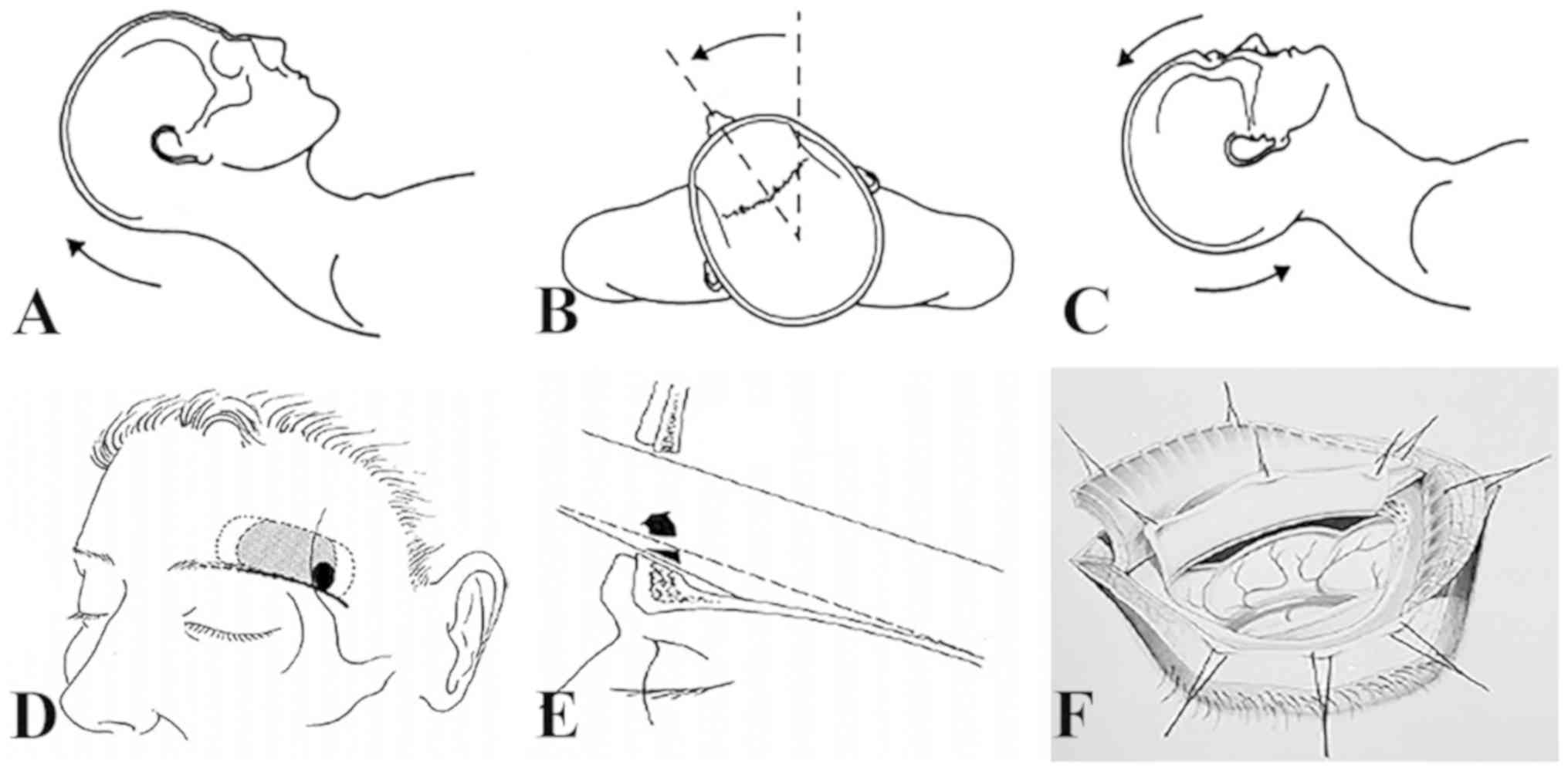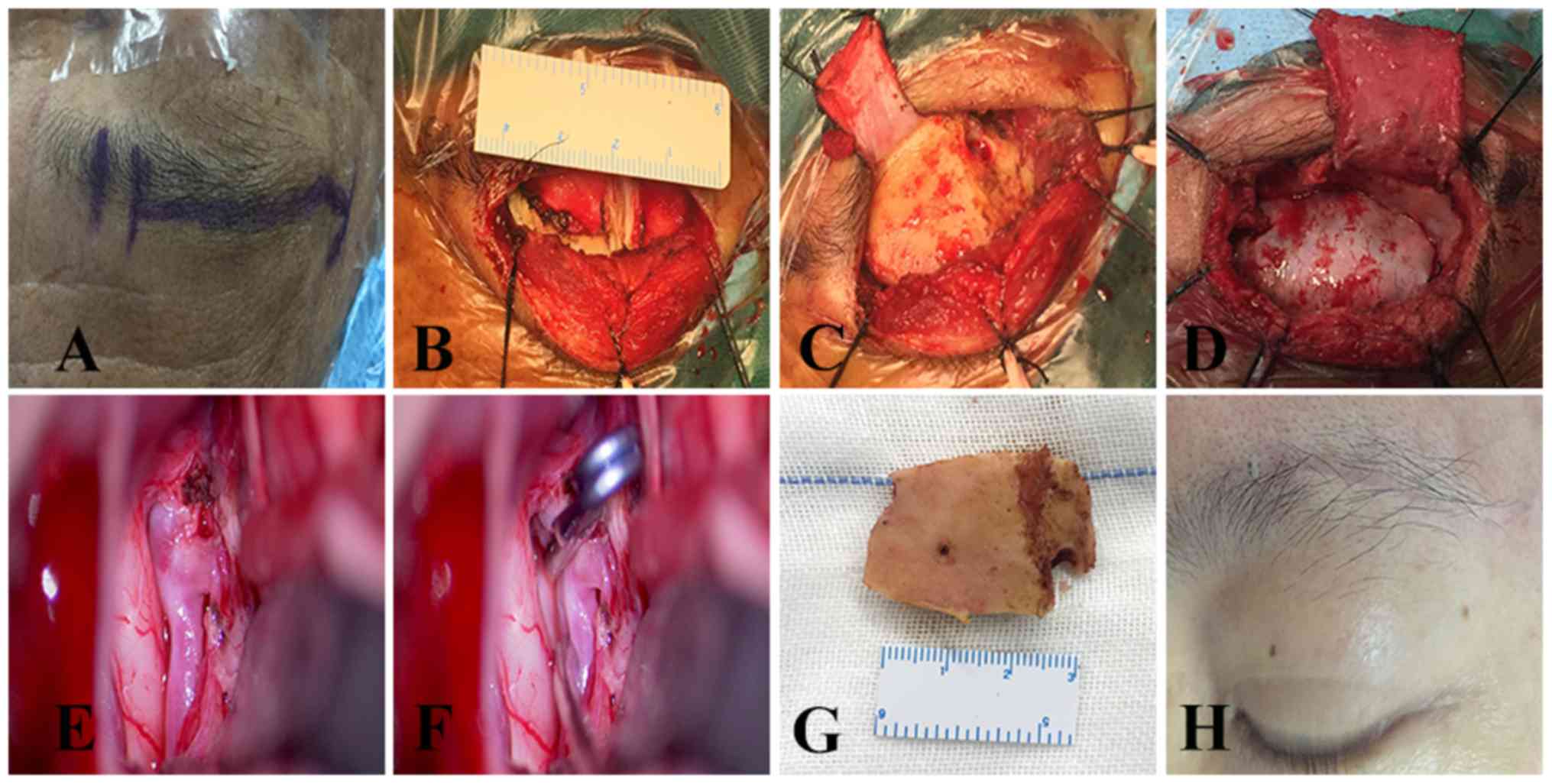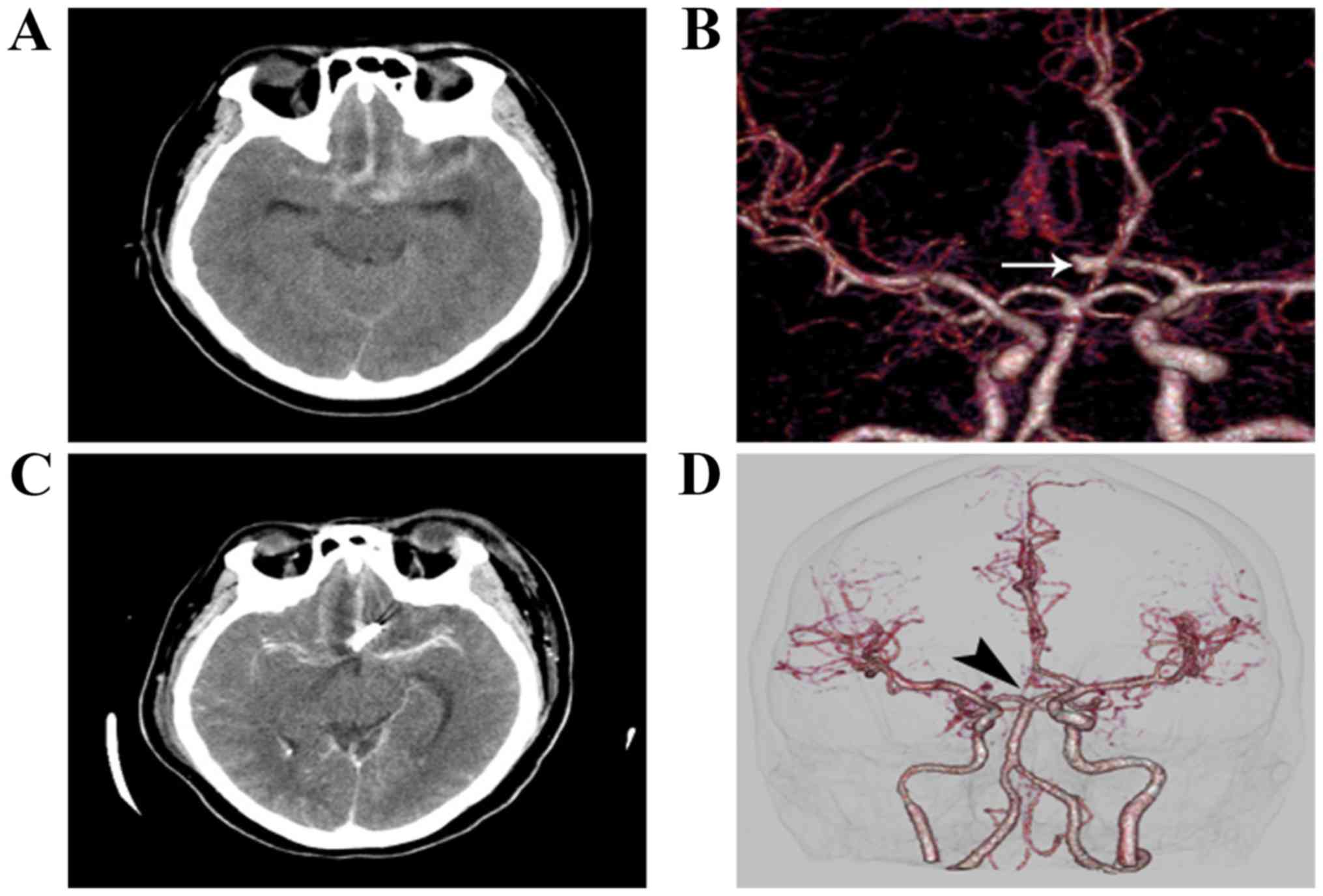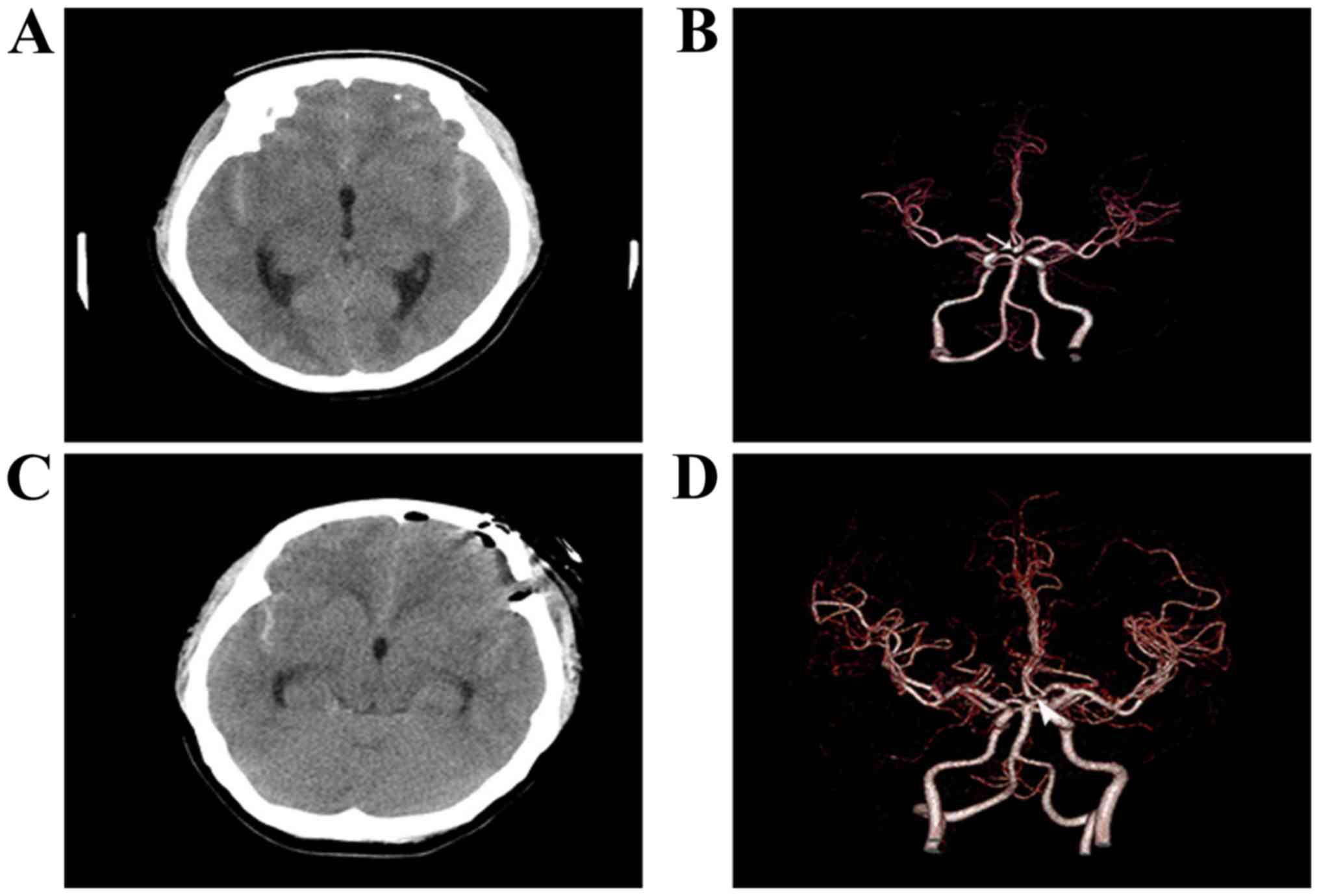|
1
|
Kassell NF, Torner JC, Haley EC Jr, Jane
JA, Adams HP and Kongable GL: The international cooperative study
on the timing of aneurysm surgery. Part 1: Overall management
results. J Neurosurg. 73:18–36. 1990.PubMed/NCBI View Article : Google Scholar
|
|
2
|
Yasargil MG: Anterior cerebral and
anterior communicating artery aneurysms. In Yasargil MG, (ed):
Microneurosurgery, New York, Georg Thieme Verlag. Vol 2:pp180–185.
1984.
|
|
3
|
Lai LT, Gragnaniello C and Morgan MK:
Outcomes for a case series of unruptured anterior communicating
artery aneurysm surgery. J Clin Neurosci. 20:1688–1692.
2013.PubMed/NCBI View Article : Google Scholar
|
|
4
|
Abla AA, Wilson DA, Williamson RW, Nakaji
P, McDougall CG, Zabramski JM, Albuque FC and Spetzler RF: The
relationship between ruptured aneurysm location, subarachnoid
hemorrhage clot thickness, and incidence of radiographic or
symptomatic vasospasm in patients enrolled in a prospective
randomized controlled trial. J Neurosurg. 120:391–397.
2014.PubMed/NCBI View Article : Google Scholar
|
|
5
|
van Lindert E, Perneczky A, Fries G and
Pierangeli E: The supraorbital keyhole approach to supratentorial
aneurysms: Concept and technique. Surg Neurol. 49:481–490.
1998.PubMed/NCBI View Article : Google Scholar
|
|
6
|
Figueiredo EG, Deshmukh P, Nakaji P,
Crusius MU, Crawford N, Spetzler RF and Preul MC: The minipterional
craniotomy: Technical description and anatomic assessment.
Neurosurgery. 61 (5 Suppl 2)(S256-S265)2007.PubMed/NCBI View Article : Google Scholar
|
|
7
|
Figueiredo EG, Deshmukh V, Nakaji P,
Deshmukh P, Crusius MU, Crawford N, Spetzler RF and Preul MC: An
anatomical evaluation of the mini-supraorbital approach and
comparison with standard craniotomies. Neurosurgery. 59 (4 Suppl
2)(ONS212-ONS220)2006.PubMed/NCBI View Article : Google Scholar
|
|
8
|
Hernesniemi J, Ishii K, Niemelä M, Smrcka
M, Kivipelto L, Fujiki M and Shen H: Lateral supraorbital approach
as an alternative to the classical pterional approach. Acta
Neurochir Suppl. 94:17–21. 2005.PubMed/NCBI View Article : Google Scholar
|
|
9
|
Nakajima H, Kamiyama H, Nakamura T,
Takizawa K and Ohata K: Direct surgical treatment of giant
intracranial aneurysms on the anterior communicating artery or
anterior cerebral artery. Neurol Med Chir (Tokyo). 53:153–156.
2013.PubMed/NCBI View Article : Google Scholar
|
|
10
|
Choi JH, Kang MJ and Huh JT: Influence of
clinical and anatomic features on treatment decisions for anterior
communicating artery aneurysms. J Korean Neurosurg Soc. 50:81–88.
2011.PubMed/NCBI View Article : Google Scholar
|
|
11
|
Froelich S, Cebula H, Debry C and Boyer P:
Anterior communicating artery aneurysm clipped via an endonasal
approach: Technical note. Neurosurgery. 68 (2 Suppl
Operative):310–316. 2011.PubMed/NCBI View Article : Google Scholar
|
|
12
|
Hunt WE and Hess RM: Surgical risk as
related to time of intervention in the repair of intracranial
aneurysms. J Neurosurg. 28:14–20. 1968.PubMed/NCBI View Article : Google Scholar
|
|
13
|
Report of World Federation of Neurological
Surgeons Committee on a Universal Subarachnoid Hemorrhage Grading
Scale. J Neurosurg: 68, 1988. Available from: https://thejns.org/view/journals/j-neurosurg/68/6/article-jns.1988.68.6.0985.xml.xml.
|
|
14
|
Fisher CM, Kistler JP and Davis JM:
Relation of cerebral vasospasm to subarachnoid hemorrhage
visualized by computerized tomographic scanning. Neurosurgery.
6:1–9. 1980.PubMed/NCBI View Article : Google Scholar
|
|
15
|
Yasargil MG: Microneurosurgery. Thieme
Stratton Inc. 2:169–184. 1984.PubMed/NCBI View Article : Google Scholar
|
|
16
|
Lin N, Cahill KS, Frerichs KU, Friedlander
RM and Claus EB: Treatment of ruptured and unruptured cerebral
aneurysms in the USA: A paradigm shift. J Neurointerv Surg.
4:182–189. 2012.PubMed/NCBI View Article : Google Scholar
|
|
17
|
Huang MC, Baaj AA, Downes K, Youssef AS,
Sauvageau E, van Loveren HR and Agazzi S: Paradoxical trends in the
management of unruptured cerebral aneurysms in the United States:
Analysis of nationwide database over a 10-year period. Stroke.
42:1730–1735. 2011.PubMed/NCBI View Article : Google Scholar
|
|
18
|
Kozba-Gosztyla M, Czapiga B and
Jarmundowicz W: Aneurismal subarachnoid hemorrhage: Who remains for
surgical treatment in the post-ISAT era? Arch Med Sci. 11:536–543.
2015.PubMed/NCBI View Article : Google Scholar
|
|
19
|
Koh KM, Ng Z, Low SY, Chua HZ, Chou N, Low
SW and Yeo TT: Management of ruptured intracranial aneurysms in the
post-ISAT era: Outcome of surgical clipping versus endovascular
coiling in a Singapore tertiary institution. Singapore Med J.
54:332–338. 2013.PubMed/NCBI View Article : Google Scholar
|
|
20
|
Niemela M, Koivisto T, Kivipelto L, Ishii
K, Rinne J, Ronkainen A, Kivisaari R, Shen H, Karatas A, Lehecka M,
et al: Microsurgical clipping of cerebral aneurysms after the ISAT
Study. Acta Neurochir Suppl. 94:3–6. 2005.PubMed/NCBI View Article : Google Scholar
|
|
21
|
Campi A, Ramzi N, Molyneux AJ, Summers PE,
Kerr RS, Sneade M, Yarnold JA, Rischmiller J and Byrne JV:
Retreatment of ruptured cerebral aneurysms in patients randomized
by coiling or clipping in the International Subarachnoid Aneurysm
Trial (ISAT). Stroke. 38:1538–1544. 2007.PubMed/NCBI View Article : Google Scholar
|
|
22
|
Spetzler RF, McDougall CG, Zabramski JM,
Albuquerque FC, Hills NK, Russin JJ, Partovi S, Nakaji P and
Wallace RC: The Barrow ruptured aneurysm trial: 6-year results. J
Neurosurg. 123:609–617. 2015.PubMed/NCBI View Article : Google Scholar
|
|
23
|
Shapiro M, Becske T, Sahlein D, Babb J and
Nelson PK: Stent-supported aneurysm coiling: A literature survey of
treatment and follow-up. AJNR Am J Neuroradiol. 33:159–163.
2012.PubMed/NCBI View Article : Google Scholar
|
|
24
|
Pierot L, Costalat V, Moret J, Szikora I,
Klisch J, Herbreteau D, Holtmannspötter M, Weber W, Januel AC,
Liebig T, et al: Safety and efficacy of aneurysm treatment with
WEB: Results of the WEBCAST study. J Neurosurg. 124:1250–1256.
2016.PubMed/NCBI View Article : Google Scholar
|
|
25
|
Moore N, Lang M and Bain M: 603.
Rehemorrhage and recurrence rates of small ACOM aneurysms post
embolization. Oral Presentations 2016 AANS Annual Scientific
Meeting Chicago, IL. J Neurosurg. 124(A1152)2016.
|
|
26
|
Daou B, Chalouhi N, Starke RM, Barros G,
Ya'qoub L, Do J, Tjoumakaris S, Rosenwasser RH and Jabbour P:
Clipping of previously coiled cerebral aneurysms: Efficacy, safety,
and predictors in a cohort of 111 patients. J Neurosurg.
125:1337–1343. 2016.PubMed/NCBI View Article : Google Scholar
|
|
27
|
Reisch R, Perneczky A and Filippi R:
Surgical technique of the supraorbital key-hole craniotomy. Surg
Neurol. 59:223–227. 2003.PubMed/NCBI View Article : Google Scholar
|
|
28
|
Yasargil MG, Reichman MV and Kubik S:
Preservation of the frontotemporal branch of the facial nerve using
the interfascial temporalis flap for pterional craniotomy.
Technical article. J Neurosurg. 67:463–466. 1987.PubMed/NCBI View Article : Google Scholar
|
|
29
|
Cheng CM, Noguchi A, Dogan A, Anderson GJ,
Hsu FP, McMenomey SO and Delashaw JB Jr: Quantitative verification
of the keyhole concept: A comparison of area of exposure in the
parasellar region via supraorbital keyhole, frontotemporal
pterional, and supraorbital approaches. J Neurosurg. 118:264–269.
2013.PubMed/NCBI View Article : Google Scholar
|
|
30
|
Yagmurlu K, Safavi-Abbasi S, Belykh E,
Kalani MYS, Nakaji P, Rhoton AL Jr, Spetzler RF and Preul MC:
Quantitative anatomical analysis and clinical experience with
mini-pterional and mini-orbitozygomatic approaches for intracranial
aneurysm surgery. J Neurosurg. 127:646–659. 2017.PubMed/NCBI View Article : Google Scholar
|
|
31
|
Paladino J, Mrak G, Miklić P, Jednacak H
and Mihaljević D: The keyhole concept in aneurysm surgery-a
comparative study: Keyhole versus standard craniotomy. Minim
Invasive Neurosurg. 48:251–258. 2005.PubMed/NCBI View Article : Google Scholar
|
|
32
|
Yu LB, Huang Z, Ren ZG, Shao JS, Zhang Y,
Wang R and Zhang D: Supraorbital keyhole versus pterional
craniotomies for ruptured anterior communicating artery aneurysms:
A propensity score-matched analysis. Neurosurgical Rev. Nov 10.
2018.PubMed/NCBI View Article : Google Scholar : (Epub ahead of
print).
|
|
33
|
Gupta SK, Chhabra R, Mohindra S, Sharma A,
Mathuriya SN, Pathak A, Tewari MK, Mukherji KK, Singla N, Salunke
P, et al: Long-term outcome in surviving patients after clipping of
intracranial aneurysms. World Neurosurg. 81:316–321.
2014.PubMed/NCBI View Article : Google Scholar
|
|
34
|
Fischer G, Stadie A, Reisch R, Hopf NJ,
Fries G, Böcher-Schwarz H, van Lindert E, Ungersböck K, Knosp E,
Oertel J and Perneczky A: The keyhole concept in aneurysm surgery:
Results of the past 20 years. Neurosurgery. 68 (1 Suppl
Operative):45–51. 2011.PubMed/NCBI View Article : Google Scholar
|
|
35
|
Molyneux AJ, Kerr RS, Birks J, Ramzi N,
Yarnold J, Sneade M and Rischmiller J: ISAT Collaborators: Risk of
recurrent subarachnoid haemorrhage, death, or dependence and
standardized mortality ratios after clipping or coiling of an
intracranial aneurysm in the International Subarachnoid Aneurysm
Trial (ISAT): Long-term follow-up. Lancet Neurol. 8:427–433.
2009.PubMed/NCBI View Article : Google Scholar
|
|
36
|
Spetzler RF, McDougall CG, Albuquerque FC,
Zabramski JM, Hills NK, Partovi S, Nakaji P and Wallace RC: The
barrow ruptured aneurysm trial: 3-year results. J Neurosurg.
119:146–157. 2013.PubMed/NCBI View Article : Google Scholar
|
|
37
|
Ogilvy CS and Carter BS: A proposed
comprehensive grading system to predict outcome for surgical
management of intracranial aneurysms. Neurosurgery. 42:959–970.
1998.PubMed/NCBI View Article : Google Scholar
|
|
38
|
Park JS, Kim H, Baik MW and Park IS: Risk
factor analysis for poor outcomes in supraorbital keyhole aneurysm
clipping for ruptured anterior circulation aneurysms. World
Neurosurgery. 111(e386-e394)2018.PubMed/NCBI View Article : Google Scholar
|
|
39
|
Chen L, Tian X, Zhang J, Huang Y, Chen E
and Lan Q: Is eyebrow approach suitable for ruptured anterior
circulation aneurysms on early stage: A prospective study at a
single institute. Acta Neurochir (Wien). 151:781–784.
2009.PubMed/NCBI View Article : Google Scholar
|
|
40
|
Paladino J, Pirker N, Štimac D and
Stern-Padovan R: Eyebrow keyhole approach in vascular neurosurgery.
Minim Invasive Neurosurg. 41:200–203. 1998.PubMed/NCBI View Article : Google Scholar
|
|
41
|
Tang C, Sun J, Xue H, Yu Y and Xu F:
Supraorbital keyhole approach for anterior circulation aneurysms.
Turk Neurosurg. 23:434–438. 2013.PubMed/NCBI View Article : Google Scholar
|
|
42
|
Chalouhi N, Thakkar V, Tjoumakaris S,
Fernando Gonzalez L, Hasan D, Rosenwasser R, Singhal S and Jabbour
PM: Microsurgical clipping of large and giant cerebral aneurysms: A
single-center contemporary experience. J Clin Neurosci.
21:1424–1427. 2014.PubMed/NCBI View Article : Google Scholar
|


















